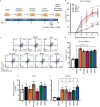Tankyrase inhibition promotes endocrine commitment of hPSC-derived pancreatic progenitors
- PMID: 39384787
- PMCID: PMC11464881
- DOI: 10.1038/s41467-024-53068-w
Tankyrase inhibition promotes endocrine commitment of hPSC-derived pancreatic progenitors
Abstract
Human pluripotent stem cells (hPSCs) have the potential to differentiate into various cell types, including pancreatic insulin-producing β cells, which are crucial for developing therapies for diabetes. However, current methods for directing hPSC differentiation towards pancreatic β-like cells are often inefficient and produce cells that do not fully resemble the native counterparts. Here, we report that highly selective tankyrase inhibitors, such as WIKI4, significantly enhances pancreatic differentiation from hPSCs. Our results show that WIKI4 promotes the formation of pancreatic progenitors that give rise to islet-like cells with improved β-like cell frequencies and glucose responsiveness compared to our standard cultures. These findings not only advance our understanding of pancreatic development, but also provide a promising new tool for generating pancreatic cells for research and potential therapeutic applications.
© 2024. The Author(s).
Conflict of interest statement
The authors declare the following competing interests: M.C.N., F.P., R.K., and F.S. have a patent application related to the use of tankyrase inhibitors for generating insulin-producing cells (US Patent App. US17/057,130). M.C.N. and F.S. have a patent licensed to Sernova Inc. (WO2013163739A1). M.C.N. has a sponsored research agreement with Universal Cells Inc. The authors declare no other competing interests.
Figures





References
-
- Xie, Z., Chang, C. & Zhou, Z. Molecular mechanisms in autoimmune type 1 diabetes: a critical review. Clin. Rev. Allergy Immunol.47, 174–192 (2014). - PubMed
-
- Cogger, K. & Nostro, M. C. Recent advances in cell replacement therapies for the treatment of type 1 diabetes. Endocrinology156, 8–15 (2015). - PubMed
-
- Katsarou, A. et al. Type 1 diabetes mellitus. Nat. Rev. Dis. Prim.3, 1–18 (2017). - PubMed
-
- Emamaullee, J. A., Pepper, A. & Shapiro, A. M. J. Islet cell transplantation. Princ. Regen. Med. 987–1007. 10.1016/B978-0-12-809880-6.00056-4 (2019).
Publication types
MeSH terms
Substances
Associated data
- Actions
Grants and funding
LinkOut - more resources
Full Text Sources
Molecular Biology Databases

